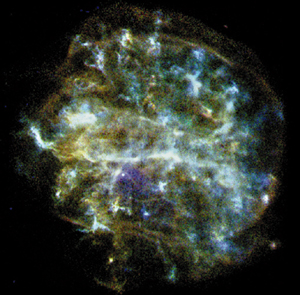In 1999 two new X-ray satellites were launched – Chandra and
XMM-Newton. Here we mark a few of their discoveries and
show some of the X-ray images that are now available to
astronomers. For the first time there is comparable resolution
between X-ray and radio observations.


X-ray equipment
X-ray astronomy can only be carried out in space because
X-rays are absorbed by the Earth’s atmosphere. The telescopes
differ from optical ones: owing to their high energy, X-rays
penetrate into a mirror in much the same way as bullets slam into
a wall; likewise, just as bullets ricochet when they hit a wall at a
grazing angle, so too will X-rays ricochet off mirrors, allowing
them to be focused.
Observations from Chandra and
XMM-Newton are complementary. The latter has a larger
collecting area than Chandra – better for observing faint sources –
but lower resolution.
New sources shed more light on active
galaxy behaviour
With the improved resolution now available to X-ray
astronomers, many new sources are being discovered. This
wealth of new data gives a boost to understanding the energetic
processes that are at work in the heart of active galaxies. Many
of the new extragalactic X-ray sources are bright and point-like,
and a significant number are probably caused by material
accreting round black holes.
In the starburst galaxy
NGC253, four black holes seem to be gravitating towards the
centre of the galaxy, where they could coalesce to form a single
supermassive black hole. The observers even suggest that
NGC253 is undergoing a transition between starburst activity
and a quasar-like galaxy. Quasars release huge amounts of
energy, outshining galaxies of hundreds of billions of stars,
from a space the size of our solar system. Each black hole would
have a mass ten to thousands of times that of the Sun. This
interpretation is a subject of great interest.
Another team
surveyed 37 different galaxies suspected of containing a
supermassive black hole in their centre. Some 25% contained
extremely luminous sources.
For the first time the periodic
variation of an X-ray source outside the Local Group of galaxies
was clearly determined – proof that it originates from a binary
system likely to contain a black hole of stellar mass.
Rapid
X-ray flaring has been detected from the compact radio source in
the Milky Way. The faintness of the associated X-ray radiation
has in the past cast doubt on whether the emission really comes
from matter accreting onto a supermassive black hole. Now, the
rapid flaring means that the model is back on track. A factor of
five change in the luminosity was detected in just 600 s. Given
the finite speed of light, the emitting region could be no bigger
than 20 times the black hole’s event horizon.
Chandra witnesses the
death of a star

The death throes of a star are shown up in X-rays by the
Chandra Observatory. The young, oxygen-rich supernova
remnant is lit up by a central radiating pulsar. Reading the pattern
of the elements that make up the remnant helps to unravel the
connection between the pulsar and the star from which it formed.
The expanding shell is 36 light-years across. The blue knots of
emission contain material that is enriched in oxygen, neon and
magnesium.








